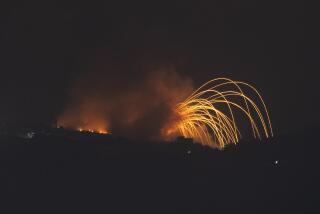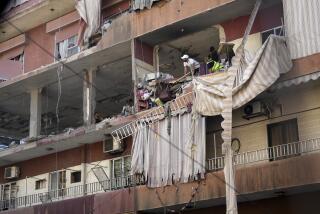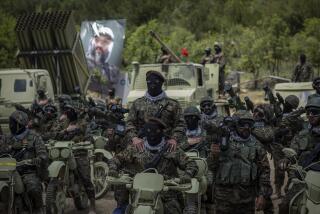Libyan battle heads to showdown in Benghazi
- Share via
Reporting from Benghazi, Libya — — Moammar Kadafi’s military and beleaguered rebel fighters are gearing for a showdown in this opposition stronghold, a battle that will help determine whether the monthlong uprising in eastern Libya can prevail — and, if not, whether a brutal regime can endure an underground resistance movement and the threat of foreign military action.
Crushing thin rebel defenses in a string of eastern coastal cities since March 6, Kadafi has bet that he can win a race against outside intervention. He has taken advantage of his military’s relative superiority to drive the rebels back toward Benghazi, where opposition leaders are now hoping foreign assistance will arrive in time for them to withstand an assault.
Late Thursday, the U.N. Security Council voted to authorize a no-fly zone and other military force against the Libyan regime. The U.S. ambassador to the United Nations had said Wednesday that Washington was prepared to support military actions beyond a no-fly zone to protect civilians.
Photos: Rebels celebrate in Tobruk
The rebels’ army, with its citizen volunteers, creaky antiaircraft guns and sand-sprayed gun trucks, is no match for Kadafi’s tanks, warplanes, gunboats and artillery. But the regime’s army is hardly a model of modern weaponry and efficiency. And Kadafi’s militias are manned by mercenaries and gunmen whose loyalty is bought.
The regime’s attack pattern has been a scaled-down version of the United States’ “shock and awe” tactics used at the start of the Iraq war in 2003. Kadafi’s forces have attacked each rebel-held city first with warplanes and then with barrages of tank and rocket fire, sending civilians fleeing while scattering poorly organized rebel fighters. His forces then storm in, allowing rebels to retreat after nightfall before finally forcing them completely out.
The question is whether this strategy will triumph in Benghazi, a much larger and more difficult target. The danger Kadafi faces is that in laying siege to Libya’s second largest city, the civilian death toll could be so high that he may provoke an overwhelming international military response.
A similar scenario unfolded in the 1990s, when Serb forces laid siege to Sarajevo, capital of Bosnia-Herzegovina. As the city held out against Serb shelling and snipers, the North Atlantic Treaty Organization eventually intervened, helping break the siege and push back the Serbs.
In Benghazi, a protracted fight in the streets would play to the rebels’ advantage. If Kadafi decides to send in troops, they would be swarmed by tens of thousands of armed rebels familiar with the city’s ancient streets and alleys.
“We will try to lure them into an area where we can even the fight,” said Gen. Abdul Fatah Younis. He stepped down as Kadafi’s interior minister to join the rebels and has emerged in the last week as the commander of a rudderless rebel force.
On Thursday, government warplanes bombed the rebel-held military airport outside Benghazi for a second day. An opposition spokesman claimed rebel warplanes had shot down two government planes, but that could not be independently verified.
Libyan state television claimed Kadafi’s forces were on the edge of Benghazi and warned residents to stay away from ammunition depots and rebel fighters. Kadafi urged his supporters to brace for a bloody onslaught.
“This meeting is for those who are ready to die, to be martyred,” he said in a speech broadcast Thursday. “These hours represent the time to write a new history, a new glory. Death is welcome. But it is death to the enemy this time.”
But it appeared that government forces still were focused on eliminating rebel resistance in Ajdabiya, 95 miles south of Benghazi. There are no rebel defenses on the road north to Benghazi, but Kadafi’s tanks and artillery were not yet in range of the rebel capital.
Both sides suffer from poor logistics. Just as the rebels outran their supply lines while winning two early battles for strategic oil cities on the Mediterranean coast, Kadafi risks extending his forces too far as they roll north toward Benghazi. He also needs to dedicate part of his force to securing the capital, Tripoli, and putting down uprisings in western cities.
“He doesn’t have large numbers, so he is really helpless because his militias are stretched and his priority will always be securing Tripoli,” said Abdallah Shaikhi, a former Libyan major now living in the United States.
In some ways, Kadafi’s policies over the last decade have anticipated this moment. He has systematically denied adequate weapons and training to army units in the east, which he long feared would rise up against him. The rebels are left with outdated weapons looted from army bases and poorly trained army defectors.
“Apart from a few mechanized units in Benghazi and Tobruk, and a few armored battalions near Beida, rebel-controlled areas lack any substantial hardware,” said Gary Li, a defense analyst with the International Institute for Strategic Studies in London.
Libya’s air force consists of a few Russian Hind helicopter gunships and at least 200 warplanes, including Soviet-built fighters and fighter bombers. But only about 15 to 40 are militarily capable, according to Shaikhi. Most are outdated Russian MiG-23s and French Mirage F-1s delivered in the late 1970s and early 1980s.
Even these aging planes are integral to Kadafi’s strategy, which relies on a command and control structure dominated by members of his tribe. Proponents of a no-fly zone have said it would eliminate the regime’s air advantage, and result in a more even fight on the ground.
Libya’s air force “is certainly not as proficient and well-trained as the Egyptian air force, or the Iraqi air force of the early 1990s. It’s clearly a rung below,” said Shashank Joshi, a fellow at the Royal United Services Institute in London.
Younis, a one-time Kadafi confidant, has become a central figure in the effort to turn the rebels into a more effective fighting force. “Our weapons are primitive . . . and our youth have relied too much on euphoria and enthusiasm,” said Younis, who was also a former chief of Kadafi’s special forces.
The rebel effort has been hampered by exuberant but wildly undisciplined young fighters who have panicked and fled in the face of government bombardments. Younis said he was integrating hundreds of trained commandos into the rebel effort against what he claimed is a government force of only 10,000 to 12,000.
Opposition leaders claim professional soldiers and commandos have taken charge of the ongoing fight in Ajdabiya, backed by fresh shipments of armored personnel carriers and ammunition.
But the rebels’ main weapons are ragged pickup trucks, known as “technicals,” mounted with heavy machine guns or old anti-aircraft guns. They are backed by grenade launchers, mortars, rockets and assault rifles.
Their most potent weapon is a small collection of obsolete T-55 tanks scattered across the desert, some in fixed positions, their cannons looking like museum pieces.
The rebels also claim a few aging warplanes and three old navy gunboats they say have attacked commercial ships outfitted with gun batteries, which Kadafi has used to pummel rebel-held cities.
The regime in Tripoli fields more modern T-62 and T-72, some of which Kadafi’s commanders displayed, cleaned and shined, for western TV cameras outside Ajdabiya on Wednesday in a clear attempt to intimidate the rebels. Particularly lethal are the government’s 2S1 self-propelled howitzers. “These are considerably more powerful than anything the rebels can muster,” Li said.
In Benghazi, opposition leaders and ordinary residents scoff at the notion of Kadafi’s forces taking their city.
Rebels have not dug in or built earthen barricades or entrenched gun positions, but that hasn’t diminished their bravado.
Asked directly whether Kadafi’s forces were capable of conquering Benghazi, Younis smiled and replied: “In their dreams.”
Photos: Rebels celebrate in Tobruk
Times staffer Henry Chu in London and special correspondent Amro Hassan in The Times’ Cairo bureau contributed to this report.
More to Read
Sign up for Essential California
The most important California stories and recommendations in your inbox every morning.
You may occasionally receive promotional content from the Los Angeles Times.












